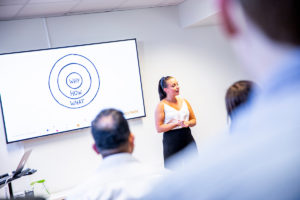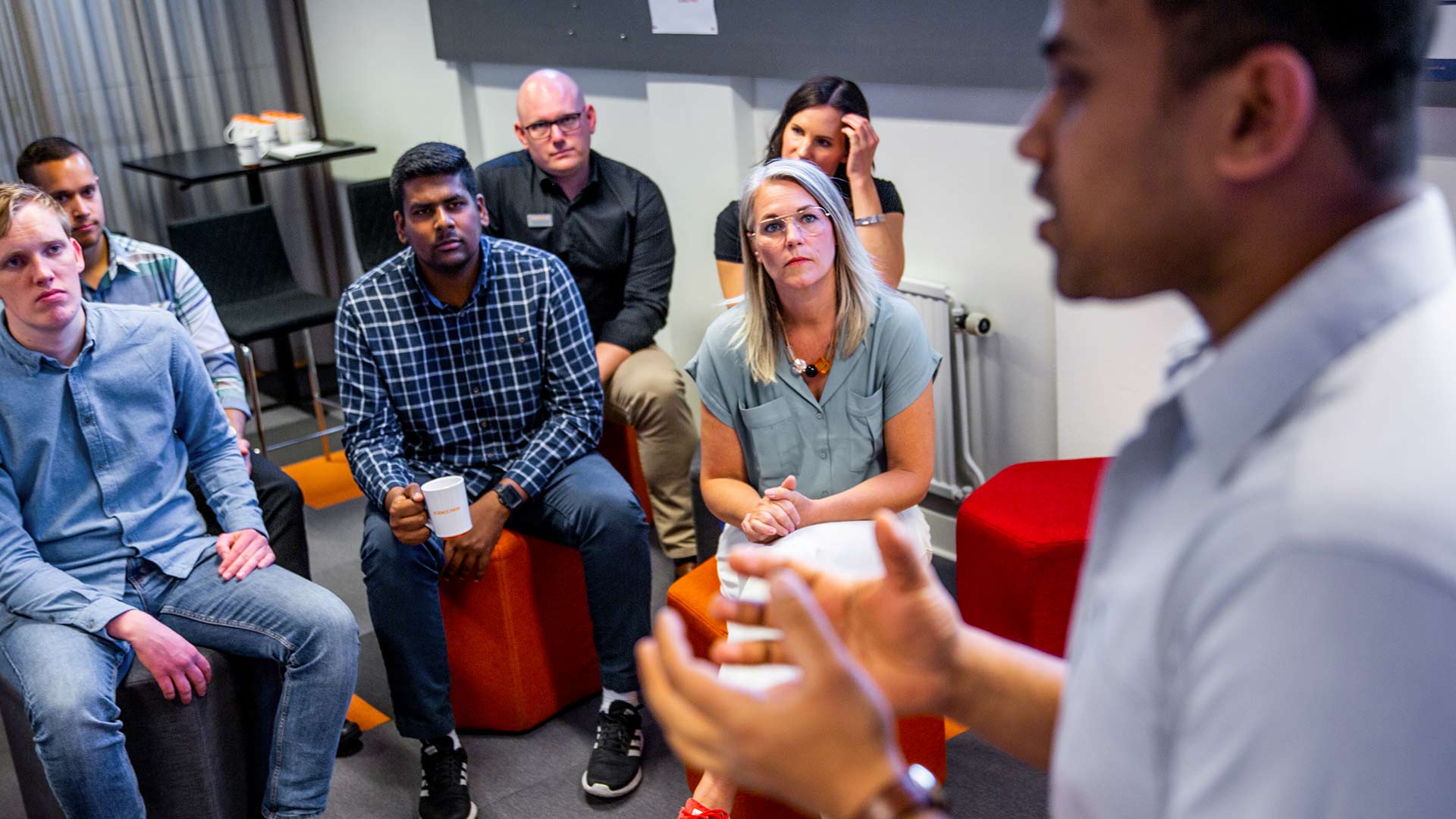Meet One of Our Business Developers
We are happy to assist you in discovering your “why.” Meeting with us is free and confidential, and you can schedule a meeting here. We look forward to learning more about your idea!
Book a meeting
The Golden Circle is a model created by entrepreneur Simon Sinek and is used to engage and inspire by clarifying the purpose of your company.
The driving force behind and the reason why you do what you do.
Your unique method or strategy.
Your specific services and products.
In what way does your business idea create a better everyday life for the many people on this Earth? Challenge yourself and your team by always asking why, why, why – until you have found the core and the true drive in your company. Values-driven companies can often explain why they exist. If you can explain your company’s values – why customers should buy from your company and not from competitors – then you have come a long way! And remember: it’s not about the price tag of your service or product, but the value it adds.
By always starting with “why” when communicating, you can create a deeper emotional connection between the customer and your brand.
According to entrepreneur and TED talk personality Simon Sinek, the key lies in what we communicate. To illustrate his idea, he has invented a simple model called “The Golden Circle.” At the core of this circle, we have “why,” surrounding it is “how,” and outermost is “what.”
Most companies communicate from the outside in. They start with “what” – the product they sell, then they explain how excellent the product is and why you should buy it. But a few companies have flipped it and start all their communication with “why”:
What drives us? What do we believe in? Why do we get up and go to work every morning?

We are happy to assist you in discovering your “why.” Meeting with us is free and confidential, and you can schedule a meeting here. We look forward to learning more about your idea!
Book a meeting
You’ve probably heard before that you should never turn to your mom for honest feedback on your new business idea. “The Mom Test” is a method for asking questions that prompt your potential customers – and even your mom – to share what they really think about your idea. The method originated in a book written by entrepreneur and author Rob Fitzpatrick and essentially revolves around asking open-ended questions about your customers’ lives without revealing anything about your solution.
Check out this thing, wouldn't it be nice to avoid doing it the old way and instead use this?
This is how it might sound when we want to test our idea in an early stage. As an entrepreneur, you know you should talk to your potential customers as early as possible – to check that you’re actually building something they will want to buy. This is important when the idea is really good – to confirm the upcoming success – but especially when it turns out that the idea doesn’t quite hold up. In that case, it’s better to find out as early as possible so that you have a better chance to adjust for success. But it’s not easy to figure out what potential customers really think. Why is that?
The first common reason is that most people try to be kind to you and therefore are not completely honest about what they think. They do this because they see that you’re putting effort, time, and money into something and simply don’t want to risk hurting you by giving feedback that might be uncomfortable.

The second common reason is that we ourselves feel good hearing positive feedback. Nothing strange about that. It’s natural that we want to hear that we are on the right track. Unfortunately, this has the consequence that we might fall into seeking compliments instead of finding valuable information where there is a risk that something uncomfortable might come up. The leading questions in the introduction are examples of this. But compliments and cheerful encouragement rarely improve our idea.
So how do you get people to say what they really think? It naturally varies depending on what idea you want to test and how far you’ve come, but in the example below, you get some tips that can help you along the way. In the example, we assume an idea for a digital service that we believe will replace a troublesome moment/problem for the customers. First, you need to confirm that there is a need among the customers.
The moment you start talking about the idea, the risk increases that they won’t really say what they think. Before that, you want to dig into how they currently handle things without influencing them in any direction.
The basic rule is to talk less and listen more! Pose open-ended questions and follow-up questions. For example: What problems do they encounter? When did it last happen? How do they currently solve the problem? Why do they do it that way? How much time do they spend solving the problem? What other methods have they tried? How challenging do they find the problem? Have they talked to others about how they handle/solve the problem? The key is to really delve into the questions so you get good information about the customer’s need for the solution.
The biggest reason we don’t ask important questions is that we’re afraid to hear the answer. Sure, it’s tough if it turns out that we’ve spent time, energy, and money on the wrong thing. But remember – it’s more important to find out early so we have a chance to make changes if needed. That’s how we create something great that customers will love! Always include a question that you’re a little afraid to ask.
So, what’s the ultimate way to check if someone is telling the truth when they say your idea is good? Ask them to sign up for the service or pre-order the product. Then, they will undoubtedly reveal what they really think – because everyone stops lying when you ask them for money.
If you want help figuring out what’s crucial for your idea to move forward, book a meeting with a business developer at Science Park, and we’ll assist you!

The MVP model (Minimum Viable Product) is about quickly launching and testing a basic version of your product or service before it’s fully developed. When you develop and test an MVP, you get valuable early-stage feedback on what works well and what needs improvement. Testing your idea early allows you to iterate and make the right adjustments without taking significant steps backward in development.
If your idea is perfect when you first launch it, you’ve probably spent too much time on it. In this guide, Linda, our Head of Community and Knowledge, will explain why.
Yes, it’s really that simple. There are no secret formulas to determine how good your idea is. There are also no experts holding the magical answer. It’s the market and your potential customers who decide, and you simply have to test your way through.
By testing your idea early on, you get feedback and avoid getting stuck in the idea phase. You also don’t have to consider what could have happened if you had just dared.
But What If I Test My Idea, and Someone Steals It?
It’s not uncommon to worry about potential idea theft. But you know what? If you don’t test, you won’t move forward, and then the idea will either fade away—or someone else will likely come up with the same thing eventually.

To satisfy today’s customer, it can be beneficial to use MLP instead of MVP, which stands for Minimum Lovable Product. To create an MLP, you should think in a similar way to creating an MVP, but with more thought and care. The goal of an MLP is to solve the problem while also bringing joy.
So, how do you create an MLP? In addition to what we’ve discussed earlier about building an MVP, you can add another mindset and model that we’ll talk about in another one of our short talks—namely, The Golden Circle and how you develop the ‘why’ of your company or product.

At Science Park, we come across around 1000 ideas each year, but one thing we will never answer is whether an idea is good or bad. The reason for that is simple – we don’t know. What we can share, however, is how you can go about figuring that out. And, of course, we’re here to assist you on that journey!
Book a meeting
The Business Model Canvas, often known as the BMC model, helps assemble crucial components and aspects of your business model. It offers a snapshot of your current understanding, rather than being a long-term strategic plan.
Using a Business Model Canvas not only helps you pinpoint areas for knowledge improvement but also underscores what is essential to focus on in the near future. The model enables visualizing and creatively exploring your business model.
Creating diverse versions of a Business Model Canvas (BMC) effortlessly enables you to demonstrate the impact of a proposed business model on different aspects of business development. Varied customer segments or revenue models may affect your costs or partnerships in distinct ways. Instead of navigating through numerous business plans or adjusting endless documents, maintain flexibility and openness to input from the external environment, customers, partners, trends, and more.
When working collaboratively, the BMC model proves to be an excellent tool for fostering a shared understanding of the work. It also provides support in mapping out various crucial areas.

Try out the BMC-Model
Download hereDescribe:
– Customer problems Your solution to the problem (i.e., your product/service)
– Benefits of the solution
– Your competitors
– Are additional societal values or values for other stakeholders achieved?
– Does it address any societal problems?
– Divide your customers into segments or suitable groupings.
– Now you can tailor your product/service to each target audience and prioritize between groups.
– Are the customer segments inclusive and free from discrimination?
– Describe how you will sell your offer to your customer groups.
– E.g., through online commerce, retailers, or direct sales.
– Are there more environmentally friendly alternatives?
– Describe how you will interact with your customers, e.g., through support or service.
– Is communication ethical and transparent?
– Describe how you will charge for your products or services.
– Include social and environmental benefits as well.
– Describe the most important activities for your venture – it could be launching, hiring, technological development, and patents.
– Can these be done in a more sustainable way?
– Are they acquired in an ethically defensible manner?
– Describe the resources needed. That is, manpower and capital to carry out your activities.
– Describe the external partners required to implement your plan.
– Do you share the same values regarding sustainability?
– The business will generate costs. Describe the main cost areas, e.g., personnel, technological development, and patents.
– Include social costs and environmental costs as well.
– What impact does our business model have on society and our planet?
– Does the business model lead to any negative impact, and what can you do to reduce it?
– Does the business model lead to any positive impact? How can the business model contribute to additional positive impact?
In our business development activities at Science Park, the BMC model stands out as one of our go-to tools. If you’d like to apply the model to your idea or business with our guidance, feel free to schedule a meeting – we’ll be in touch soon.

If you’re unsure about how to successfully attract investors and secure venture capital for your company, here are our top pieces of advice!
Seeking capital from private investors requires careful preparation. You should have a clear understanding of what you’re seeking and what unfolds from the moment you decide to collaborate. You need to articulate your business plan and vision for the future clearly.
Focus on explaining the concept during the meeting – namely, the problem your company solves and for whom. An investor often wants to see a clear logic in the problem your idea addresses and how you create value for the intended customer. Therefore, you need to articulate your solution in an easily understandable way, even if it is multi-faceted and can evolve in several directions. Many investors are simply looking for ideas they can easily grasp and understand.
Who makes up the team that will lead the company, and why are these the right individuals for the job?
Describe the market, its segments, the company’s target audiences, and the reasons behind targeting those specific groups.
Share information about your competitors and how your company distinguishes itself from them.
Illustrate how the company will generate revenue and provide an overview of the financial projections.
Are there any intellectual property rights, such as patents, in place?

Keep in mind that you’re addressing an investor who aims to yield a return on their investment in your company during your presentation. Ensure you fully grasp the company’s financial path, including future capital needs and how you intend to use that capital. Simply put, demonstrate how the company’s profitability is expected to unfold.
If the initial meeting sparks the investor’s interest, they will seek more information, delve into the company, its market, and get to know the team driving the business. Securing venture capital is not a task accomplished within a week. Typically, the process takes 3-9 months from initial contact to the completion of the investment, so it’s crucial to plan ahead.

Many companies receive a rejection after the initial meeting. This doesn’t necessarily mean your business idea is flawed but rather that the idea may not align with the investor at the moment. It could be due to a lack of industry expertise to work with your company or the recognition of alternative funding sources, such as Almi or a bank, that could better address your capital needs.
Another reason for investor rejection could be that your business hasn’t progressed far enough, and they want to see additional evidence that the market is positively responding to your product/service. Investment firms typically enter the scene after the startup phase, expecting some level of revenue in the company.
It’s essential to be aware that securing external capital is a challenging process. Of the companies we encounter through our investment fund, Spectria Invest, only 5-10% successfully navigate the entire process and secure their investment. The advice for those facing rejection, whether from us or another source, is to embrace the feedback and move on to other investors. Seek individuals with a background in your industry or who invest in similar ventures and persist in presenting your idea until you succeed.

The NABC model serves as a tool to define your idea and prepare a concise pitch by challenging you to think through what truly makes the idea valuable for your intended customers. In this guide, you’ll get a quick overview of the different parts of the NABC model. You can also download the model to continue working on it independently.
Describe the needs of the customer, market, society, or other stakeholders.
What is the problem, and for whom?
What does the customer care about, and what values does the customer hold?
In what way is the need confirmed?
Explain your unique approach to satisfying the identified need.
Can the approach be made more sustainable in terms of, for example, manufacturing, material choices, transportation, working conditions, and inclusivity?
Describe the quantified benefit in relation to the customer’s cost.
Value = Benefit/Cost. Does your idea have a positive impact on society and the climate? Does it contribute positively to the United Nations’ 17 global sustainability goals?
Who are the competitors or other alternatives that can satisfy the need?
In what ways can sustainability create additional competitive advantages?
Many invest a significant amount of time in the ‘Approach’ section, solely focusing on their solution and how it should look. We believe it’s crucial to begin with the ‘Need,’ meaning a clear need or problem. It’s easy to go astray with both the solution and marketing if you don’t truly understand the underlying need.
By navigating through the model, you gain a clearer understanding of the problems to be addressed, enabling you to construct a robust and clear business idea.

Try Out the NABC Model
Download hereIf you distill the information from the four areas of the NABC model into a concrete offering, it becomes an excellent brief explanation of your business idea. This can be used when sharing what you do during a meeting or on your website.
By adding a ‘hook’ (an introduction that generates interest and reaction) before your NABC and a ‘closer’ (something that makes the listener remember) after the model, you have a perfect pitch.
Need assistance going through the model? Book a meeting with us, and we’ll go through it together!